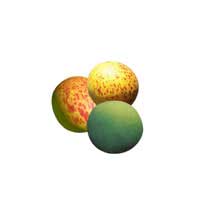 Full List of Fruits
Full List of Fruits  Mangaba Fruit
Mangaba FruitMangaba Fruit
Scientific name - Hancornia speciosa
Indigenous to Brazilian tropical areas, Hancornia speciosa commonly known as Mangaba is also a timber tree in the Apocynaceae family of Hancornia genus. Considered functional for beekeeping, the tree grows to a height of 5-6 metres, however can reach 10 metres. This plant is native from Brazil, typically in Amazon Rainforest, Caatinga, and Cerrado vegetation. Having said that, they are most abundant in the highlands and plains along the coast of the Northeast Region and parts of the Restinga! It is often confused by non-Portuguese speakers with mango because of the similarity of their names.
With red pigmentation, Mangaba is the fruit of the mangabeira tree, and it is oval and berry-shaped, yellow or greenish in color. When ripe it exudes a very aromatic delicate smell and has a yellow skin with reddish marks. With a one of its kind, sweet flavor, they are they are slightly gelatinous and fibrous; however it has a soft flesh. Native people who know the fruit well used them widely and called it Mangaba which means "good fruit for eating". Flavor- The juice of Mangaba when combined with cachaca makes an appetizing caipifruta cocktail. It's a very easy tang to like, uncomplicated, sweet and delicious. With a number of small seeds, the flesh of the fruit is very spongy.
![]() Nutritional Value of Mangaba Fruit
Nutritional Value of Mangaba Fruit
| Nutritions | value |
| Energy | 66.21 Kcal |
| Protein | 1.20% |
| Lipids | 2.37% |
| Carbohydrates | 10.0% |
| Fiber | 3.40% |
| Minerals | 0.6% |
| Calcium | 35mg |
| Zinc | 1.0 mg |
| Phosphorus | 18mg |
| Iron | 2.8mg |
| Vitamin A | 30µg |
| Vitamin B1 | 40µg |
| Vitamin B2 | 40µg |
| Niacin | 33µg |
Seeing that, they are so perishable, the fruit of Mangaba is used mainly for industrial processing i.e. into ice-cream, juice and jam. The process of freezing will come into play for commercial uses. They are also used for making pastries, preserves, distillates, wines and syrups. In earlier times, the latex of the tree was used for making rubber; however this is no longer the case.
![]() Health benefits of Mangaba Fruit
Health benefits of Mangaba Fruit
Parts of the tree are being involved in folk medicine; the skin is loaded with astringent properties and a concoction of the leaves help in menstrual pain. Spaced out from this, the latex is used for treating:
 Bruises
Bruises
 Inflammation
Inflammation
 Tuberculosis
Tuberculosis
 Diarrhea
Diarrhea
 Ulcers and
Ulcers and
 Herpes
Herpes
When the fruit is all set, it falls from the stem and finishes ripening on the ground over an interlude of 12 - 24 hours. With that said, fruits gathered from the ground are highly prized, but when ripe, Mangaba will perish soon, hence it must be consumed soon. The easily perishable Mangaba creates a problem for commercialization, as a result, the fruits are mostly picked from the tree and the produce is ready to eat after two to four days. As with this case, some experience is essential to make out exactly when to harvest the fruit.


















